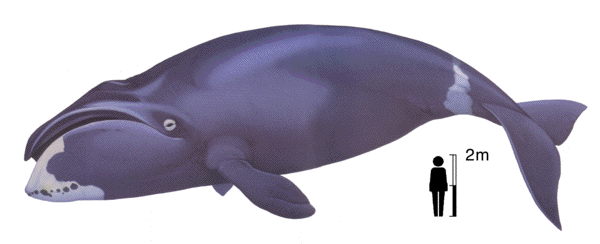The Bowhead Whale
(Balaena mysticetus)
The Bowhead whale was named for its distinctive bow-shaped skull, which is enormous; about 40% of total body length. It is the only large whale living exclusively in the Arctic. Its blubber is up to 70cm (28in) thick, helping it to withstand the extreme cold. When the Bowhead finds itself under the ice it can create its own breathing holes by breaking through ice up to 30cm (12in) thick. The whale can grow to a length of 15m - 18.5m (female larger than male) and weigh between 60 - 80 tonnes.

Click here for a bigger Image
In profile, adult Bowheads have a broad triangular head, a deep depression behind the blowhole and a rounded back. Younger animals have a rounder back and show a single rounded shape from the snout to the flukes. The Bowhead has a smooth back with no dorsal fin, hump or ridge. It has a black (occasionally brown or greyish-black) body except for a white or ochreous chin patch (often with beadlike string of dark grey or black spots). Some individuals have a light grey band on the underside of the tail stock around its thinnest part. This whale has the longest baleen plates of any cetacean species. The baleen plates are dark grey or black, may have a whitish edge, and appear iridescent green. As with the Right whales there are no baleen plates at the front of the mouth and no throat groves.
The whale's skin is smooth with no callosities or growths. Its two blowholes are widely separated, giving a V-shaped blow rising to 7m (23ft). The flukes have a distinct notch, are very wide and can equal almost half the body length. Flippers are broad and paddle shaped but considerably narrower and shorter (relative to body size) than those of the Right whales.
Family: Balaenidae
Other Names: Greenland Right Whale, Arctic Whale, Arctic Right Whale, Great Polar Whale
Bowhead whales (like the Right whales) feed primarily by skimming with their mouths open through surface concentrations of plankton. Occasionally Bowheads have been seen feeding while swimming on their sides with their mouths open. Other modes of feeding include stirring up clouds of mud from the bottom similar to the actions of Gray whales, "column feeding" where the whale dives and surfaces in the same place and "mud tracking" where the animal swims in straight tracks through shallow water, stirring the muddy bottom with its large tail.
Distribution of the Bowhead is circumpolar confined to the Arctic, associated with ice. There are five separate populations with the bulk of the world population concentrated in the Bering, Chukchi and Beaufort Seas. Another population exists in the Sea of Okhotsk, a third in the Davis Straight and Baffin Bay, a fourth around Hudson Bay and a relict population in Greenland and Barents Seas. Bowheads migrate relative to the formation and movement of ice, north in summer, south in winter. Mating and calving occurs in spring and early summer during the early stages of the migration northeast. This migration occurs in three or four pulses, and follows ice leads close to the coast through the Bering Strait into the Chukchi Sea and then past Point Barrow, Alaska, into the Beaufort Sea.
The Bowhead Whale has been protected, since 1935, worldwide by international law. It is one of the most seroiusly endangered of all the large whales. It was hunted to near extinction from a population of around 50,000 and although the present number is uncertain it has been estimated at about 7,800. To this day the native Inupiat Eskimos of Alaska have insisted on killing a number of Bowheads each year for cultural needs in local commumities. This hunt has been most controversial within the International Whaling Commission and the world.
| Bibliography | Whales on the Net |